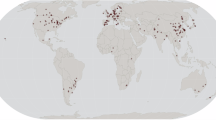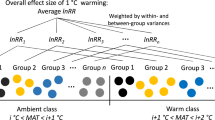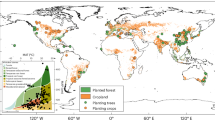Abstract
Soils can be either a source or sink of atmospheric CO2 depending on how soil organic carbon (SOC) responds to climate warming and changes in plant productivity. Whereas warming typically accelerates SOC decomposition, the effect of plant productivity changes remains unclear. Here we use a space-for-change substitution approach to analyse a global dataset of SOC measurements down to 1 metre. We find that warming-induced SOC reduction in the 0–0.3-m topsoil is gradually offset by increasing plant productivity but exacerbated in the 0.3–1-m subsoil until plant productivity increase crosses a threshold of 30%. Consequently, entirely offsetting warming-induced SOC reduction in the top metre of soil requires an unrealistically high increase in plant productivity, albeit with substantial variance across ecosystems. Soil carbon-to-nitrogen ratio is the dominant predictor of the variance in SOC response, as this ratio determines whether nitrogen released during carbon loss meets the requirement for additional plant growth or whether additional nitrogen must be mined from soil organic matter. Such mining accelerates SOC losses, particularly in the subsoil, where the soil carbon-to-nitrogen ratio is lower than in topsoils. We conclude that globally, increased plant productivity may exacerbate SOC losses under climate warming, particularly in the subsoil.
This is a preview of subscription content, access via your institution
Access options
Access Nature and 54 other Nature Portfolio journals
Get Nature+, our best-value online-access subscription
$32.99 / 30 days
cancel any time
Subscribe to this journal
Receive 12 print issues and online access
$259.00 per year
only $21.58 per issue
Buy this article
- Purchase on SpringerLink
- Instant access to full article PDF
Prices may be subject to local taxes which are calculated during checkout





Similar content being viewed by others
Data availability
The latest WoSIS dataset24 can be accessed at https://www.isric.org/news/wosis-new-set-standardized-soil-profiles-released-wosislatest-june-2022. The MODIS NPP data can be accessed at https://lpdaac.usgs.gov/products/mod17a3hgfv061/. The field-observation-derived NPP and its allocation in soil layers dataset can be gained from ref. 26. Other data used in this study are the same as those used in ref. 4, which are publicly accessible. The coastline data in all maps are publicly accessible and can be accessed at https://www.naturalearthdata.com/downloads/50m-physical-vectors/50m-coastline/. Source data are provided with this paper.
Code availability
Code (R scripts developed using R version 4.2.2) used to assess the data and generate the results are accessible via figshare at https://doi.org/10.6084/m9.figshare.25859092 (ref. 65).
Change history
14 May 2025
In the version of the article initially published, the editor recognition statement was incorrect and has been amended to “Primary Handling Editors: Xujia Jiang and Stefan Lachowycz, in collaboration with the Nature Geoscience team.” in the HTML and PDF versions of the article.
References
Friedlingstein, P. et al. Global carbon budget 2023. Earth Syst. Sci. Data 15, 5301–5369 (2023).
Davidson, E. A. & Janssens, I. A. Temperature sensitivity of soil carbon decomposition and feedbacks to climate change. Nature 440, 165–173 (2006).
Crowther, T. W. et al. Quantifying global soil carbon losses in response to warming. Nature 540, 104–108 (2016).
Wang, M. M. et al. Global soil profiles indicate depth-dependent soil carbon losses under a warmer climate. Nat. Commun. 13, 5514 (2022).
Cui, J. et al. Elevated CO2 levels promote both carbon and nitrogen cycling in global forests. Nat. Clim. Change 14, 511–517 (2024).
Lie, Z. et al. Warming leads to more closed nitrogen cycling in nitrogen-rich tropical forests. Glob. Chang. Biol. 27, 664–674 (2020).
Varney, R. M. et al. Simulated responses of soil carbon to climate change in CMIP6 Earth system models: the role of false priming. Biogeosciences 20, 3767–3790 (2023).
Van Sundert, K. et al. When things get MESI: the Manipulation Experiments Synthesis Initiative—a coordinated effort to synthesize terrestrial global change experiments. Glob. Chang. Biol. 29, 1922–1938 (2023).
Keenan, T. F. et al. A constraint on historic growth in global photosynthesis due to rising CO2. Nat. Clim. Change 13, 1376–1381 (2023).
Fernández-Martínez, M. et al. Global trends in carbon sinks and their relationships with CO2 and temperature. Nat. Clim. Change 9, 73–79 (2018).
Schimel, D., Stephens, B. B. & Fisher, J. B. Effect of increasing CO2 on the terrestrial carbon cycle. Proc. Natl Acad. Sci. USA 112, 436–441 (2014).
Terrer, C. et al. A trade-off between plant and soil carbon storage under elevated CO2. Nature 591, 599–603 (2021).
Xu, S. et al. Positive soil priming effects are the rule at a global scale. Glob. Chang. Biol. 30, e17502 (2024).
Niu, S., Song, L., Wang, J., Luo, Y. & Yu, G. Dynamic carbon-nitrogen coupling under global change. Sci. China Life Sci. 66, 771–782 (2023).
Butler, S. M. et al. Soil warming alters nitrogen cycling in a New England forest: implications for ecosystem function and structure. Oecologia 168, 819–828 (2011).
Du, E. et al. Global patterns of terrestrial nitrogen and phosphorus limitation. Nat. Geosci. 13, 221–226 (2020).
Pendall, E., Osanai, Y., Williams, A. L. & Hovenden, M. J. Soil carbon storage under simulated climate change is mediated by plant functional type. Glob. Chang. Biol. 17, 505–514 (2011).
Carrillo, Y., Dijkstra, F., LeCain, D., Blumenthal, D. & Pendall, E. Elevated CO2 and warming cause interactive effects on soil carbon and shifts in carbon use by bacteria. Ecol. Lett. 21, 1639–1648 (2018).
Hartmann, H., Bahn, M., Carbone, M. & Richardson, A. D. Plant carbon allocation in a changing world—challenges and progress: introduction to a Virtual Issue on carbon allocation Introduction to a virtual issue on carbon allocation. N. Phytol. 227, 981–988 (2020).
Mueller, K. E. et al. Root responses to elevated CO2, warming and irrigation in a semi‐arid grassland: integrating biomass, length and life span in a 5‐year field experiment. J. Ecol. 106, 2176–2189 (2018).
Hicks Pries, C. E. et al. The deep soil organic carbon response to global change. Annu. Rev. Ecol. Evol. Syst. 54, 375–401 (2023).
He, Y. et al. Radiocarbon constraints imply reduced carbon uptake by soils during the 21st century. Science 353, 1419–1424 (2016).
Xiao, L. J. et al. Younger carbon dominates global soil carbon efflux. Glob. Chang. Biol. 28, 5587–5599 (2022).
Batjes, N. H., Calisto, L. & de Sousa, L. M. Providing quality-assessed and standardised soil data to support global mapping and modelling (WoSIS snapshot 2023). Earth Syst. Sci. Data 16, 4735–4765 (2024).
Running, S., Mu, Q. & Zhao, M. MOD17A3H MODIS/Terra Net Primary Production Yearly L4 Global 500m SIN Grid V006 (NASA EOSDIS Land Processes Distributed Active Archive Center, 2015).
Xiao, L. J. et al. Global depth distribution of belowground net primary productivity and its drivers. Glob. Ecol. Biogeogr. 32, 1435–1451 (2023).
Wieder, W. R., Cleveland, C. C., Smith, W. K. & Todd-Brown, K. Future productivity and carbon storage limited by terrestrial nutrient availability. Nat. Geosci. 8, 441–444 (2015).
Smith, W. K. et al. Large divergence of satellite and Earth system model estimates of global terrestrial CO2 fertilization. Nat. Clim. Change 6, 306–310 (2016).
Li, P. et al. Quantification of the response of global terrestrial net primary production to multifactor global change. Ecol. Indic. 76, 245–255 (2017).
Hu, Q. & Feng, S. A daily soil temperature dataset and soil temperature climatology of the contiguous United States. J. Appl. Meteorol. Climatol. 42, 1139–1156 (2003).
Song, J. et al. A meta-analysis of 1,119 manipulative experiments on terrestrial carbon-cycling responses to global change. Nat. Ecol. Evol. 3, 1309–1320 (2019).
Liu, S. et al. Climatic role of terrestrial ecosystem under elevated CO2: a bottom-up greenhouse gases budget. Ecol. Lett. 21, 1108–1118 (2018).
Elser, J. J., Fagan, W. F., Kerkhoff, A. J., Swenson, N. G. & Enquist, B. J. Biological stoichiometry of plant production: metabolism, scaling and ecological response to global change. N. Phytol. 186, 593–608 (2010).
Wen, Z., White, P. J., Shen, J. & Lambers, H. Linking root exudation to belowground economic traits for resource acquisition. N. Phytol. 233, 1620–1635 (2021).
Macdonald, C. A., Delgado-Baquerizo, M., Reay, D. S., Hicks, L. C. & Singh, B. K. in Soil Carbon Storage (ed. Singh, B. K.) 167–205 (Academic Press, 2018).
Dijkstra, F. A., Carrillo, Y., Pendall, E. & Morgan, J. A. Rhizosphere priming: a nutrient perspective. Front. Microbiol. 4, 126 (2013).
Terrer, C., Vicca, S., Hungate, A. B., Phillips, R. P. & Prentice, I. C. Mycorrhizal association as a primary control of the CO2 fertilization effect. Science 353, 72–74 (2016).
Terrer, C. et al. Ecosystem responses to elevated CO2 governed by plant-soil interactions and the cost of nitrogen acquisition. N. Phytol. 217, 507–522 (2018).
Pedersen, E. P., Elberling, B. & Michelsen, A. Foraging deeply: depth-specific plant nitrogen uptake in response to climate-induced N-release and permafrost thaw in the High Arctic. Glob. Chang. Biol. 26, 6523–6536 (2020).
McKinley, D. C., Romero, J. C., Hungate, B. A., Drake, B. G. & Megonigal, J. P. Does deep soil N availability sustain long‐term ecosystem responses to elevated CO2? Glob. Chang. Biol. 15, 2035–2048 (2009).
Nakayama, M. et al. Quantitative importance of subsoil nitrogen cycling processes in Andosols and Cambisols under temperate forests. Appl. Soil Ecol. 201, 105485 (2024).
Odone, A., Popovic, O. & Thorup-Kristensen, K. Deep roots: implications for nitrogen uptake and drought tolerance among winter wheat cultivars. Plant Soil 500, 13–32 (2023).
Zelikova, T. J. et al. Long-term exposure to elevated CO2 enhances plant community stability by suppressing dominant plant species in a mixed-grass prairie. Proc. Natl Acad. Sci. USA 111, 15456–15461 (2014).
Langley, J. A. & Megonigal, J. P. Ecosystem response to elevated CO2 levels limited by nitrogen-induced plant species shift. Nature 466, 96–99 (2010).
Cotrufo, M. F., Ineson, P. & Scott, A. Elevated CO2 reduces the nitrogen concentration of plant tissues. Glob. Chang. Biol. 4, 43–54 (2002).
Xu, Q., Wang, X. & Tang, C. The effects of elevated CO2 and nitrogen availability on rhizosphere priming of soil organic matter under wheat and white lupin. Plant Soil 425, 375–387 (2018).
Pausch, J., Holz, M., Zhu, B. & Cheng, W. Rhizosphere priming promotes plant nitrogen acquisition by microbial necromass recycling. Plant Cell Environ. 47, 1987–1996 (2024).
Tang, B., Rocci, K. S., Lehmann, A. & Rillig, M. C. Nitrogen increases soil organic carbon accrual and alters its functionality. Glob. Chang. Biol. 29, 1971–1983 (2023).
Hu, Y. et al. Depth‐dependent responses of soil organic carbon under nitrogen deposition. Glob. Chang. Biol. 30, e17247 (2024).
Bishop, T. F. A., McBratney, A. B. & Laslett, G. M. Modelling soil attribute depth functions with equal-area quadratic smoothing splines. Geoderma 91, 27–45 (1999).
Luo, Z. K., Viscarra-Rossel, R. A. & Qian, T. Similar importance of edaphic and climatic factors for controlling soil organic carbon stocks of the world. Biogeosciences 18, 2063–2073 (2021).
Mishra, U. et al. Spatial heterogeneity and environmental predictors of permafrost region soil organic carbon stocks. Sci. Adv. 7, eaaz5236 (2021).
Batjes, N. H. Harmonized soil property values for broad-scale modelling (WISE30sec) with estimates of global soil carbon stocks. Geoderma 269, 61–68 (2016).
Zhao, M. S. & Running, S. W. Drought-induced reduction in global terrestrial net primary production from 2000 through 2009. Science 329, 940–943 (2010).
Koven, C. D. et al. The effect of vertically resolved soil biogeochemistry and alternate soil C and N models on C dynamics of CLM4. Biogeosciences 10, 7109–7131 (2013).
Fick, S. E. & Hijmans, R. J. WorldClim 2: new 1-km spatial resolution climate surfaces for global land areas. Int. J. Climatol. 37, 4302–4315 (2017).
Olson, D. M. et al. Terrestrial ecoregions of the world: a new map of life on Earth. BioScience 51, 933–938 (2001).
Channan, S., Collins, K. & Emanuel, W. Global Mosaics of the Standard MODIS Land Cover Type Data (Univ. of Maryland & Pacific Northwest National Laboratory, 2014).
Meybeck, M., Green, P. & Vörösmarty, C. A new typology for mountains and other relief classes: an application to global continental water resources and population distribution. Mt. Res. Dev. 21, 34–45 (2001).
Soudzilovskaia, N. A. et al. Global mycorrhizal plant distribution linked to terrestrial carbon stocks. Nat. Commun. 10, 5077 (2019).
Wang, M. et al. Responses of soil organic carbon to climate extremes under warming across global biomes. Nat. Clim. Change 14, 98–105 (2023).
Allen, M., Mustafa, B. & Shukla, P. Global Warming of 1.5 °C (eds Masson-Delmotte, V. et al.) (Cambridge Univ. Press, 2018).
Maes, S. L. et al. Environmental drivers of increased ecosystem respiration in a warming tundra. Nature 629, 105–113 (2024).
Strayer, D. et al. Long-term ecological studies: an illustrated account of their design, operation, and importance to ecology. Adv. Ecol. Acad. Sin. 5, 51–55 (1988).
Wang, M. Increasing plant productivity exacerbates global soil carbon losses under a warmer climate due to nitrogen mining. figshare https://doi.org/10.6084/m9.figshare.25859092.v3 (2024).
Acknowledgements
This research has been financially supported by the National Natural Science Foundation of China (grant numbers 32241036, 32171639) and the Postdoctoral Fellowship Program and China Postdoctoral Science Foundation (grant number BX20240314).
Author information
Authors and Affiliations
Contributions
Z.L. conceived the study; M.W. compiled the data with the contribution of G.W., L.X. and Z.L.; M.W. and Z.L. designed the approach and data assessment procedure; M.W. conducted the data assessment and wrote the first draft; Z.L. revised the paper with the contributions of all authors.
Corresponding author
Ethics declarations
Competing interests
The authors declare no competing interests.
Peer review
Peer review information
Nature Geoscience thanks Ben Bond-Lamberty, Emanuele Lugato and the other, anonymous, reviewer(s) for their contribution to the peer review of this work. Primary Handling Editors: Xujia Jiang and Stefan Lachowycz, in collaboration with the Nature Geoscience team.
Additional information
Publisher’s note Springer Nature remains neutral with regard to jurisdictional claims in published maps and institutional affiliations.
Extended data
Extended Data Fig. 1 The global distribution of soil profiles among biomes.
The number behind biomes is the sample size of soil profiles in the biome. This data contains the latest WoSIS24. TS forests, tropical/subtropical forests; Med/Mon shrublands, Mediterranean/montane shrublands; TS grasslands/savannas, tropical/ subtropical grasslands/savannas. Coastline data from Natural Earth (https://www.naturalearthdata.com/downloads/50m-physical-vectors/50m-coastline).
Extended Data Fig. 2 Schematic representation of the approach used to quantify the response of soil organic carbon (SOC) to plant productivity changes and warming.
Each dot represents one SOC observation. Dots in the ith plate share the same mean annual temperature (MATA, i) and plant productivity (NPPA, i), while dots in the same color plates indicate a group sharing the same mean annual precipitation (MAP), precipitation seasonality, landform, and soil type. ΔNPP (shown in Supplementary Table 1) and ΔT (1.5 °C in this study) are changes in NPPA and MATA of interest, respectively. SOC values in the warming (W), and warming plus NPP changes (W+NPP) plates are compared to the values in the ambient (A) plates in the same group to calculate a weighted average effect size (i.e., the response of SOC to ΔT, and ΔT + ΔNPP) by the inverse of the sum of within- and between-group variances, using meta-analytic techniques (Methods). Figure adapted with permission from ref. 4, Springer Nature Limited.
Extended Data Fig. 3 Changes in belowground net primary productivity (BNPP) allocation.
a, the changes [(BNPP0.3-1 m/BNPP-Treatment – BNPP0.3-1 m/BNPP-Control) / (BNPP0.3-1 m/BNPP-Control)] in BNPP allocated into subsoil (0.3–1 m) on a global scale. b, the changes in BNPP allocated into subsoil among ecosystems. Dashed line shows the 1:1 line. The shading envelope represents the 95% confidence interval, with the corresponding similar colour solid line shows the average. TS forests, tropical/subtropical forests; Med/Mon shrublands, Mediterranean/montane shrublands; TS grasslands/savannas, tropical/ subtropical grasslands/savannas.
Extended Data Fig. 4 Changes in belowground net primary productivity (BNPP) under warming and NPP change scenarios.
a, BNPP changes coincide total NPP changes in all three soil depth layers on a global scale. b, BNPP changes in three soil depth layers among ecosystems. Dashed line shows the 1:1 line. The shading envelope represents the 95% confidence interval, with the corresponding similar colour solid line shows the average. TS forests, tropical/subtropical forests; Med/Mon shrublands, Mediterranean/montane shrublands; TS grasslands/savannas, tropical/ subtropical grasslands/savannas.
Extended Data Fig. 5 The performance of random forest model for predicting global soil organic carbon changes induced by 20% NPP increase.
The colour solid line is the regression line. The grey dotted line represents 1:1 line.
Extended Data Fig. 6 The difference of soil carbon:nitrogen ratio between two soil depth layers.
Boxplots show the median and interquartile range (IQR), with whiskers extending to the most extreme values within the 1.5 times of IQR. n represents the sample size. P values are for two-tailed tests.
Extended Data Fig. 7 Percentage shift of ecosystem types induced by plant productivity changes under warming.
The percentage shift is calculated as the fraction of ecosystem types at each profile location in the W+NPP group that are different from the ecosystem type in the A group. Boxplots show the median and interquartile range (IQR), with whiskers extending to the most extreme values within the 1.5 times of IQR. The red point represents the average. The numbers at the top of the box are the sample size.
Supplementary information
Supplementary Information
Supplementary Figs. 1–4 and Tables 1 and 2.
Supplementary Data 1
Statistical source data.
Supplementary Data 2
Statistical source data.
Source data
Source Data Fig. 1
Statistical source data.
Source Data Fig. 2
Statistical source data.
Source Data Fig. 3
Statistical source data.
Source Data Extended Data Fig. 3
Statistical source data.
Source Data Extended Data Fig. 4
Statistical source data.
Source Data Extended Data Fig. 5
Statistical source data.
Source Data Extended Data Fig. 6
Unprocessed data.
Source Data Extended Data Fig. 7
Statistical source data.
Rights and permissions
Springer Nature or its licensor (e.g. a society or other partner) holds exclusive rights to this article under a publishing agreement with the author(s) or other rightsholder(s); author self-archiving of the accepted manuscript version of this article is solely governed by the terms of such publishing agreement and applicable law.
About this article
Cite this article
Wang, M., Zhang, S., Wang, G. et al. Increased plant productivity exacerbates subsoil carbon losses under warming via nitrogen mining. Nat. Geosci. 18, 510–517 (2025). https://doi.org/10.1038/s41561-025-01697-1
Received:
Accepted:
Published:
Issue date:
DOI: https://doi.org/10.1038/s41561-025-01697-1



